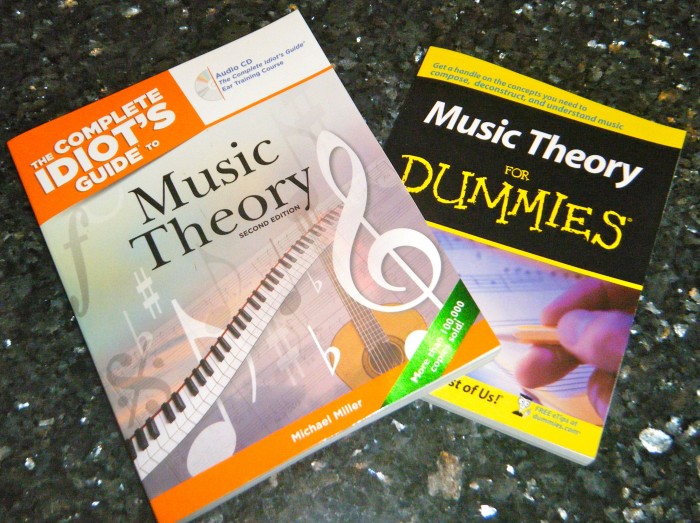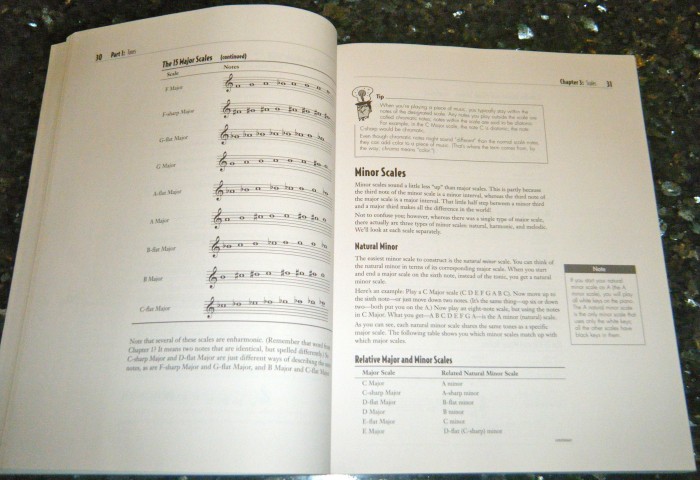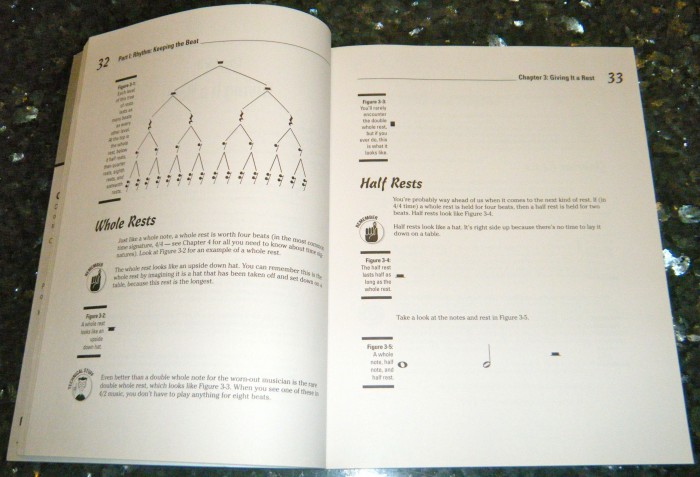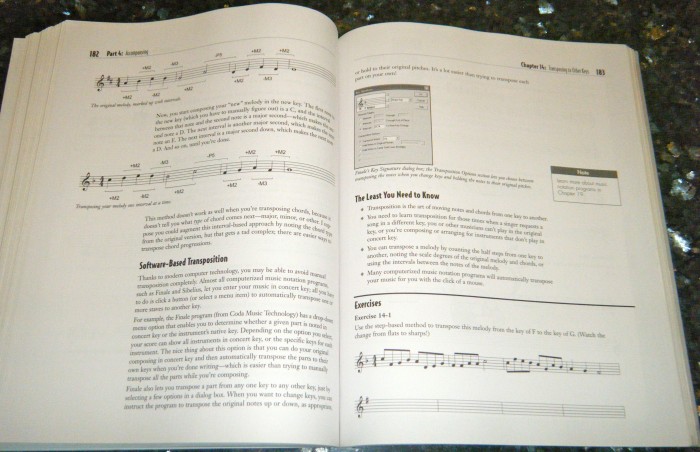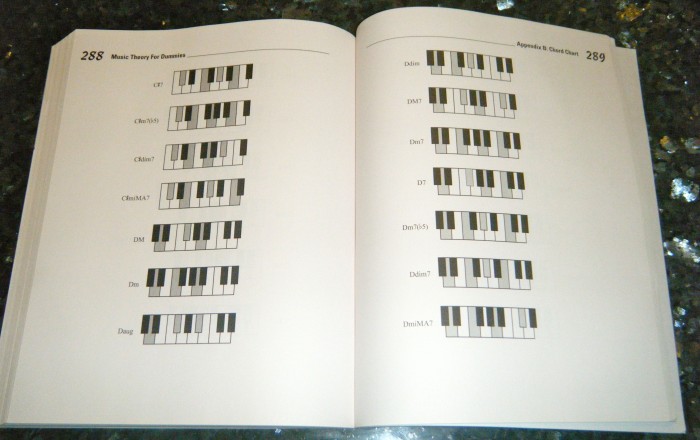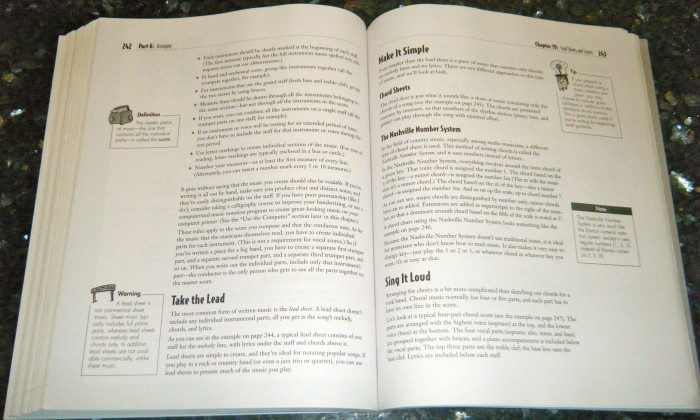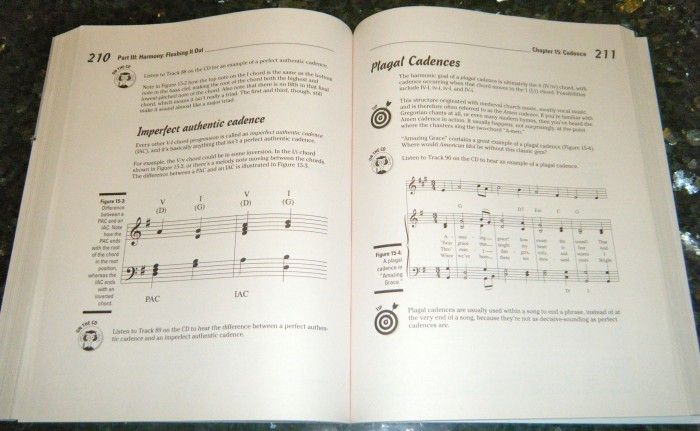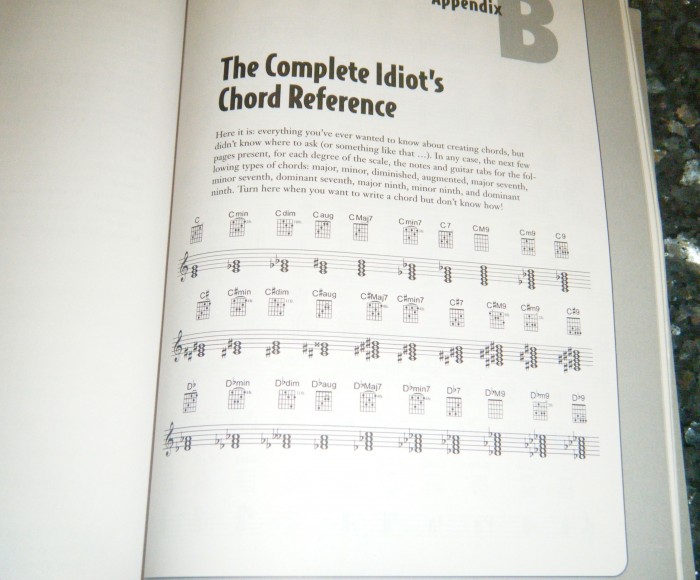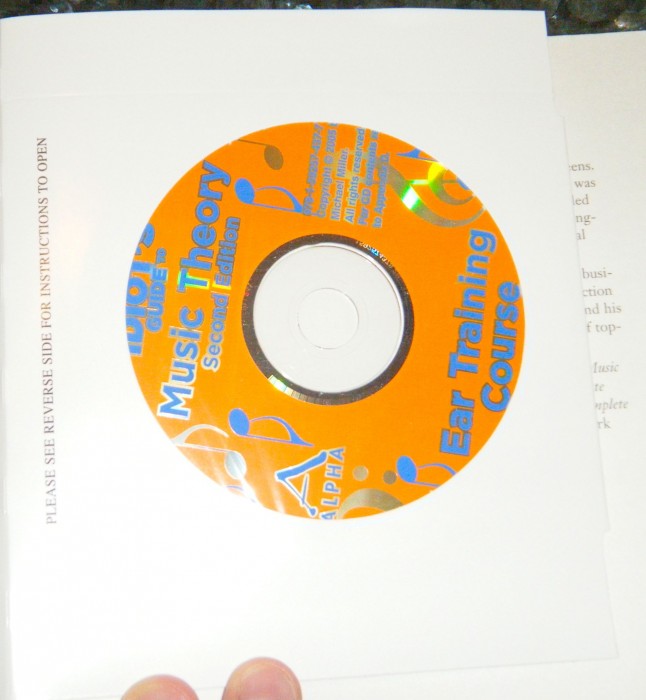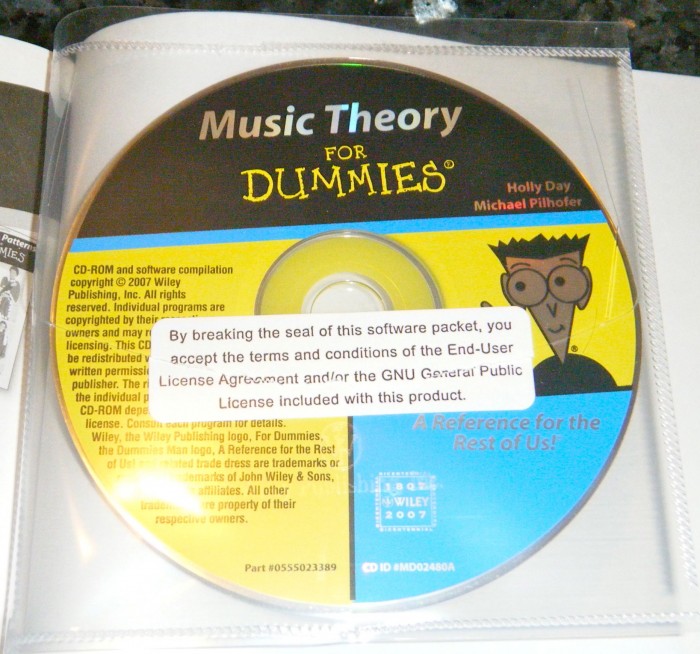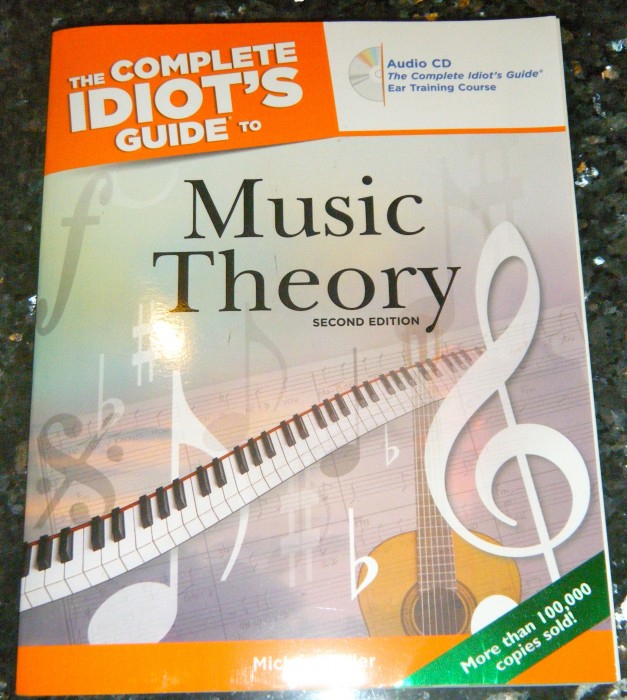It has been 20 years now since the first book to simultaneously insult and help us came along – DOS for Dummies. Though met with skepticism based on the title, the folks behind the ‘for Dummies’ book said that it was a term of endearment … and that rapidly advancing technology made many people FEEL like dummies! When given a chance, the book took off and the foundation was built for a new type of technology guides: ones built for everyday people!
Soon after we saw a new series that has become nearly as popular through the years, called “The Complete Idiot’s Guide” series. Both series were initially very software technology focused, but have branched out to teaching us about everything from stocks to quilting to … well, Music Theory!
The publishers of the Complete Idiot’s Guides contacted a number of bloggers to take an ‘Idiots vs. Dummies’ challenge. I selected Music Theory, and have been working through both books with my younger son to find out which we like better … read on and find out!
The Hype:
The Complete Idiot’s Guide® to Music Theory: This updated and expanded edition of The Complete Idiot’s Guide® to Music Theory breaks down a difficult subject in a simple way—even for those who think they have no rhythm or consider themselves tone deaf. With clear, concise language, it explains everything from bass-clef basics to confusing codas.
Music Theory for Dummies: Music Theory For Dummies gives you a friendly, unintimidating overview of the material covered in a typical college-level course and makes music theory easy to understand. It includes updated information on current teaching techniques; the newest music examples and genres; information on mastering major and minor scales, using intervals, and recognizing pitches and clefs; the lowdown on rhythms, tempo, dynamics, and navigation; how to transcribe the music you hear and transposing it to other keys; harmonizing and accompanying melodies; composing and arranging for voices and instruments; performing your own music; and much more.
The Reality:
Each of these books attempts to take the complex subject of music theory and break it into logical chunks to help someone untrained in music approach the subject and walk away with a working knowledge. The bottom line is this – both books are EXCELLENT at dealing with the core material. Plowing through these books over the course of several weeks, my son and I came to the same basic conclusion – you can’t lose either way. Of course, there ARE some differentiating factors, and not all choices went in a single direction! All of which made the choice even tougher as to which book we preferred … but in the end we came to a decision, and it WAS unanimous!
The Format:
Common Themes: Both guides recognize the need to integrate sheet music, key positions, visual cues, and other elements with the text to provide an appealing guide. And they both do a very effective job of making their guides visually appealing.
The Complete Idiot’s Guide® to Music Theory
Idiot’s Guide: The Idiot’s Guide is *huge* – a full 1.5″ taller and 1″ wider than the Dummies book, the authors put that space to work. They provide loads of annotations, big margins, comments, examples, tips and so on – all without breaking the flow of the text.
Music Theory for Dummies
Dummies: Being physically smaller has two side-effects for the Dummies book – the font is smaller, and utilizing images tends to be more disruptive to the overall flow of text. The text size makes it harder to put the book at a distance to use while also playing a guitar or piano. In terms of flow, on some pages it seems like half the space is empty between graphics and annotations occupying more room than text.
Getting Started:
Common Themes: Given that the simple definition of music (stated best in the introduction to the Idiot’s Guide) is a series of tones organized according to a specified rhythmic pattern, it makes sense that these books start with either notes or rhythm.
The Complete Idiot’s Guide® to Music Theory
Idiot’s Guide: Here we start with the notes – pitches, clefs, intervals, scales and keys. Given that it is the first few chapters of the book, I found it rather dry in terms of presentation and appeal to the reader. The content is excellent, which I will highlight later – but the beginning a book like this is the easiest place to lose a half-hearted reader, something I fear could happen here.
Music Theory for Dummies
Dummies: Starting with rhythm seems like the smarter way to go, which is what the Dummies book does. Since from the earliest age we are pounding on things, tapping out a rhythm is not something that will make someone self-conscious. I found myself quickly tapping rhythms and turning pages, and before you know it the Rhythm section was done. As I said before, an author could choose either approach, but after spending time with both books I prefer the way Dummies ordered things.
The ‘Meat’:
Common Themes: I have written and erased individual sections on harmony, melody, scales, cycles, advanced theory, and so on. The reason is simple; both guides do a solid job of introducing the reader to everything they need to know in terms of studying music theory, with general nuances I explain below that carry through every section.
The Complete Idiot’s Guide® to Music Theory
Idiot’s Guide: When dealing with graphics-rich instruction, formatting really does matter – and with the Idiot’s Guide I found that the larger size allowed the book to simply get out of the way and let things flow naturally. Graphics easily allow text to flow, tips stay in the margin and allow for plenty of note-taking, and in general there was just a load of content that worked very well and maintained readability throughout.
Music Theory for Dummies
Dummies: Once again revisiting the formatting, I found that the depth of the lessons, and examples and explanations were impacted to a small extent by the way the Dummies guide packed information on the pages. The bottom line is this – each guide uses about the same number of pages, but in the Dummies guide you lose extra area for graphics, tips and annotations that would fit in the margin or allow text to flow around in the Idiot’s Guide. Add to this the extra space spend on keyboard fingerings, tablature and other nomenclature explanations. It is not drastic, and it is unlikely I would have really noticed without a direct comparison, but on a page-by-page, section-by-section basis I got more content from the Idiot’s Guide.
The ‘Extras’:
Common Themes: Once again we see both guides looking at the same core idea ‘you know some theory, NOW what?’ and taking it in different directions. While to an extent this is subjective, I feel very strongly about one approach compared to the other … as you will see!
The Complete Idiot’s Guide® to Music Theory
Idiot’s Guide: When you think about the progression of musical knowledge, you learn notes and rhythm, chords and sequences, melody and harmony, then put it all together into compositions. Along the way it is important to learn to transcribe stuff you hear – every instrumentalist does this as a matter of learning … and generally drives their family nuts as a result. Transcription leads to transposition, leads to arranging and larger forms, and eventually to creating your musical vision for others to play. Sounds amazing, right? Well, THAT is the flow of the last half of the Idiot’s Guide.
Dummies: After you get through the core of music theory, the Dummies guide takes a very strange ‘left turn’. You have a section on ‘shape’ and ‘form’, and then suddenly you are getting into some ‘frequently asked questions’ and little blurbs about various music theorists. It is light and fluffy and feels like filler – I didn’t just trudge through 250 pages to be reading a couple of paragraphs on Bob Moog!
The CD:
Common Themes: Each guide provides a CD that augments and supplements the material in the book. They are both excellent, and I really have no preference of one over the other.
The Complete Idiot’s Guide® to Music Theory
Idiot’s Guide: The Idiot’s Guide provides a complete ear-training course on the CD, which nicely augments the core teaching throughout the book.
Music Theory for Dummies
Dummies: Since the core material of the book is dedicated to music theory without going beyond in the same way the Idiot’s Guide does, it makes sense that the focus is on audio examples of the music theory lessons provided.
Conclusions:
Idiot’s Guide: While I wasn’t shocked that the Idiot’s Guide was an excellent music theory book, I was surprised at how so many of the little details and decisions made such a big difference. Idiot’s guide started off at a disadvantage for me by introducing notes before rhythm, but the better integration of text and images, the better use of space on the page, and the overall deeper presentation of the material made a huge difference in my appreciation of the material.
Dummies: The Dummies guide provides exactly what you would expect – a solid instructional guide to learning music theory. I loved the way the book started with rhythm, as I found that highly engaging. I did notice how the smaller format forced smaller fonts and didn’t allow as much freedom for the authors to integrate graphics and text comfortably. Overall a solid guide.
Recommendation: As I said at the start, you will not end up disappointed with either guide, as both accomplish the task of teaching music theory admirably while keeping it interesting throughout. However, based on the depth of subject matter, continuity from most basic to more advanced concepts without any filler, and visual design that made for a more pleasant experience, I would recommend the Complete Idiot’s Guide to Music Theory. Add in the fact that the book is 20% cheaper than the Dummies guide, and it is a no brainer!
Comparison Review: Are You an ‘Idiot’ or a ‘Dummy’ Music Theorist?
Where to Buy: IdiotsGuides.com
(Amazon has Dummies guide for $15.98, Complete Idiots Guide for $13.57)
Price: $19.99
What I Like: Both books provide excellent subject matter coverage; great CD included; excellent value
What Needs Improvement: Dummies guide suffers formatting issues; Idiot’s guide would benefit by starting with rhythm.
Source: Publisher provided copies
